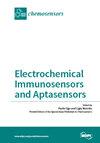含硅倍半氧烷的超薄聚合物薄膜对用于可调生物标记物检测的金属氧化物气体传感器性能的影响
IF 3.7
3区 工程技术
Q2 CHEMISTRY, ANALYTICAL
引用次数: 0
摘要
呼出气体中的某些生物标志物是人体疾病的指标。对人体呼气中此类生物标志物的非侵入式检测,增加了对简单、经济的气体传感器的需求,以取代最先进的气相色谱仪(GC)。基于薄膜结构的金属氧化物(MOX)气体传感器的使用解决了目前呼气检测仪的局限性。然而,在高湿度条件下(即人体呼出的气体),MOX 传感器的灵敏度会大大降低,从而难以检测到微量的生物标记物。我们在之前的工作中提出了混合气体传感器的概念,即基于薄膜的 MOX 气体传感器与通过无溶剂化学气相沉积(iCVD)沉积的超薄(20-30 纳米)聚合物表层相结合。疏水性表层使传感器能够在高湿度条件下进行测量,并能精确调节选择性和灵敏度。本文介绍了一种通过对聚合物表层进行化学修饰来提高混合传感器氢气(H2)灵敏度的方法。我们在之前的一项研究中已经应用了聚(1,3,5,7-四甲基-四乙烯基环四硅氧烷) (PV4D4) 薄膜,通过简单的加热步骤,它就变成了含有硅倍半氧烷的表层。在 350 °C 的工作温度下,这种转变使 H2 的气体响应显著增加了约 709%。这些结果为分析呼出气体(H2 表示胃肠道疾病)的生物医学应用领域揭示了新的途径。本文章由计算机程序翻译,如有差异,请以英文原文为准。
Influence of Silsesquioxane-Containing Ultra-Thin Polymer Films on Metal Oxide Gas Sensor Performance for the Tunable Detection of Biomarkers
Certain biomarkers in exhaled breath are indicators of diseases in the human body. The non-invasive detection of such biomarkers in human breath increases the demand for simple and cost-effective gas sensors to replace state-of-the-art gas chromatography (GC) machines. The use of metal oxide (MOX) gas sensors based on thin-film structures solves the current limitations of breath detectors. However, the response at high humidity levels, i.e., in the case of exhaled human breath, significantly decreases the sensitivity of MOX sensors, making it difficult to detect small traces of biomarkers. We have introduced, in previous work, the concept of a hybrid gas sensor, in which thin-film-based MOX gas sensors are combined with an ultra-thin (20–30 nm) polymer top layer deposited by solvent-free initiated chemical vapor deposition (iCVD). The hydrophobic top layer enables sensor measurement in high-humidity conditions as well as the precise tuning of selectivity and sensitivity. In this paper, we present a way to increase the hydrogen (H2) sensitivity of hybrid sensors through chemical modification of the polymer top layer. A poly(1,3,5,7-tetramethyl-tetravinylcyclotetrasiloxane) (PV4D4) thin film, already applied in one of our previous studies, is transformed into a silsesquioxane-containing top layer by a simple heating step. The transformation results in a significant increase in the gas response for H2 ~709% at an operating temperature of 350 °C, which we investigate based on the underlying sensing mechanism. These results reveal new pathways in the biomedical application field for the analysis of exhaled breath, where H2 indicates gastrointestinal diseases.
求助全文
通过发布文献求助,成功后即可免费获取论文全文。
去求助
来源期刊

Chemosensors
Chemistry-Analytical Chemistry
CiteScore
5.00
自引率
9.50%
发文量
450
审稿时长
11 weeks
期刊介绍:
Chemosensors (ISSN 2227-9040; CODEN: CHEMO9) is an international, scientific, open access journal on the science and technology of chemical sensors published quarterly online by MDPI.
 求助内容:
求助内容: 应助结果提醒方式:
应助结果提醒方式:


